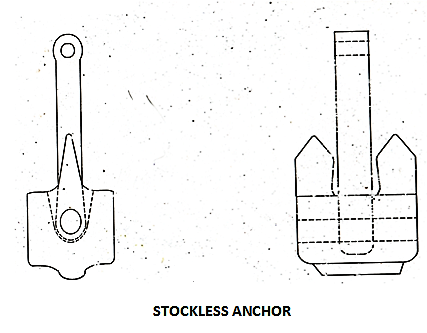Ship Anchor
A ships anchor is an important component, used to prevent the ship from drifting from its location due to wind and tidal currents. Generally, larger ships having two bow and one stern anchor. Anchors can either be temporary or permanent. Permanent anchors are used in the creation of a mooring, and are rarely moved; a specialist service is normally needed to move or maintain them. Vessels carry one or more temporary anchors, which may be of different designs and weights. The anchoring equipment of a ship comprises the anchor, anchor chain and the windlass. Anchor chains are connected to a windlass that can either be of vertical or horizontal design. A vertical windlass is known as a capstan, and we shall describe the operation of the anchor and its components using a capstan.
The capstan has a drive wheel called a gypsy that is notched to suit the forged steel chain links.
The chain is fed from the capstan along the deck of the fo’c’sle head through a pawl and down through a hawsepipe pipe in the deck exiting at the ships bow. From here the chain drops downwards and is connected to the anchor using a shackle whose hardened steel pin passes through a hole drilled in the anchor central shank.
The modern ship’s anchor is called ‘Stock-less Bower anchor and is developed from the primitive “ stock Anchor”.

The modern Bower stockless anchor is in existence since the days of steam propulsion and has been developed to suit the stowing arrangement in the hawse pipe of the ship and with a lower holding strength than the stock anchor. The modern stockless anchor has a holding strength of five times its weight in Newtons, whereas the ancient or primitive stock anchor has a holding strength of ten times its weight in Newtons. The reason for this requirement of lightness is that the anchor has to be hauled quickly (within 30 minutes maximum ), when the weather deteriorates during anchor stay and the ship has to haul up the anchor and proceed to sea. A stock anchor will take longer time to haul up and therefore endanger the safety of the ship. In the worst condition it can lead to capsizing of the ship especially if it is in light condition or in the best condition drag anchor and run aground ashore. Whereas in a sailing ship the ship is normally anchored deep inside the natural harbour where the severity of the sea condition does not reach. It should be understood that the greater the holding force , the larger time required to haul up the anchor. The forces acting on a ship riding anchor is described in next blog.


Comments
Post a Comment